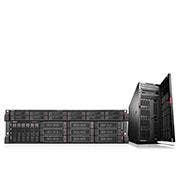Lenovo Targets Enterprise With New Power-Efficient, SSD-Toting Servers

Lenovo unveiled Monday its fifth-generation portfolio of servers based on the new Intel Xeon processor E5-2600 v3 Grantley family.
The new Lenovo servers, including two rack mount models and a tower server, target enterprise solution providers and their customers with the ability to perform at consistently higher temperatures than normal and with new flexibility aimed at helping them work with customers' existing environments, said Dave Lincoln, director of Lenovo's enterprise product marketing.
Lenovo's new server line comes at a time when the company is starting to capitalize on its strategic relationship with EMC and preparing to take over the x86 business of IBM, Lincoln told CRN.
[Related: Q2 2014 Server Sales: HP Rules While IBM, Dell Slip]
Lenovo has made the enterprise its top strategic initiative," he said. "While our PC business is great, it's a water-from-a-stone business (in terms of profits). A lot of money is coming from servers. We love the server business. We're investing."
The server business in some ways appears to love Lenovo as well.
IDC last week reported second quarter Lenovo server shipments up 47.7 percent over last year to just more than 77,000 units, leading to a 62.7 percent year-over-year rise in server revenue to $145 million.
Included in the rollout is the Lenovo ThinkServer RD550, a 1U rack mount server that can be configured with up to 12 drives and 26 TBs of internal storage and up to eight 10-Gb Ethernet ports with an option for four 10-Gbit Ethernet ports and two 16-Gbit Fibre Channel ports.
Also new is the Lenovo ThinkServer RD650, a 2U rack mount server with space for up to 26 drives and 74 TBs of storage capacity. Both rack mount servers can be configured with up to 768 GBs of DDR4 memory.
Lenovo also introduced the Lenovo ThinkServer TD350, a scalable tower server with up to two of the new processors, up to 512GBs of DDR4 memory and up to 90 TBs of storage capacity.
A key feature of Lenovo's new servers is their energy efficiency, said Bob Zuber, director of product planning and strategy for the vendor.
Lenovo has adopted the ASHRAE A4 control standard to run continuously at 113 degrees Fahrenheit or 45 degrees Celsius to significantly cut cooling requirements, Zuber told CRN.
"Every single degree increase in operating temperature leads to a 4 to 5 percent increase in cost and cooling savings," he said. "Many other vendors do not run the ASHRAE A4 level continuously."
NEXT: Better Understanding The Heat Problem, Or Is There A Problem?
One Lenovo solution provider, who requested anonymity because of the sensitivity of its relationships with other server vendors, told CRN that having servers that can run at 113 degrees continuously is nice until one remembers that the networking and other gear in the data center still require cooling.
"It's meaningless now for the data center," the solution provider said. "But the overall data center temperature could rise as the networking and other gear start running at higher temperatures as well. But it will take time before people start cranking the data center heat up."
The high-temperature feature of the Lenovo servers make much more sense in branch offices or SMBs where servers are more likely to be sitting in a closet than in a purpose-built data center, the solution provider said.
"In the middle of nowhere, no one wants to deal with HVAC," the solution provider said. "Servers get shoved in the closet. The Lenovo solution is perfect there. Customers can buy a lot of servers compared to the cost of HVAC."
Herb Hogue, senior vice president of engineering and services at En Pointe Technologies, a Gardena, Calif.-based solution provider and Intel partner, told CRN he agreed servers that run at higher temperatures are great for SMB server closets.
"SMBs are the guys who will put a server in a closet and expect it to work for 20 years," Hogue said.
However, he said, most servers don't run continuously at sustained rates.
"If we were talking GPUs, that would be different," he said. "But CPUs aren't running at that requirement often. It may be more relevant in high performance computing environments, but less in standard server scenarios."
The new Lenovo servers also include the company's AnyRAID solution which allows any RAID adaptors to connect to the server backplane; AnyFabric to allow choice of networking fabric; and AnyBay technology to allow the use of any SAS, SATA or PCIe drives, Zuber said.
The anonymous solution provider likes the flexibility offered by AnyRAID, AnyBay and AnyFabric.
"It's smart on Lenovo's part," the solution provider said. "Any environment Lenovo goes into will be heterogeneous. They're late to the data center, so they will have to fit in with any environment. And the 'Any' name is a good use of the language from a marketing perspective."
NEXT: M2 Connector For Mini Boot SSDs
The new Lenovo servers also feature an M2 connector for miniature SSDs that can be used to decrease boot time, Zuber said.
"Customers are looking for how to decrease boot times," he said. "In the past, administrators configured VMware ESXi on USB drives to boot. But USB drives are really a consumer product. Now users can connect two M2 devices to the mainboard, or continue using USB drives."
Using M2 SSDs as the boot drive could actually lower the total mean time before failure rate of servers, Hogue said.
"Two things drive 90 percent of server problems: spinning drive failures and power supply failures, because they have moving parts," he said. "If you add SSDs for the boot drive, you eliminate one of the problems. And servers all come with redundant power supplies anyway."
PUBLISHED SEPT. 8, 2014